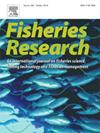Abundance and distribution of larval and early juvenile fish in Puck Lagoon and outer Puck Bay in the southern Baltic Sea
IF 2.2
2区 农林科学
Q2 FISHERIES
引用次数: 0
Abstract
Puck Bay, regarded as a crucial region along the Polish coastline, has witnessed a decline in fish taxa diversity and abundance over the past several years. The objective of this study was to ascertain the abundance and geographical distribution of fish larvae in Puck Lagoon and outer Puck Bay over the period from April to the end of September. A neuston net with a 300-μm mesh was utilized at 10–15 stations situated in the shallow coastal waters of the study area. A total of 13 taxa were identified among the larvae captured. The majority of larvae observed during the entire study period were identified as Gobiidae. Furthermore, the most abundant taxa were three-spined stickleback, broad-nosed pipefish, straight-nosed pipefish, Ammodytidae, and sprat. The presence of larvae belonging to other taxa, including herring, flounder, cod, turbot, fourbeard rockling, and roach, was observed on a sporadic basis. Details such as Shanon’s diversity Index, the month of larval presence, geographical distribution, and differences in abundance and body size between Puck Lagoon and outer Puck Bay were recorded. The findings indicated that the study area was characterized by a limited diversity of fish taxa. Furthermore, the majority of these taxa (e.g., Gobiidae, broadnose and straight-nosed pipefishes) are not the subject of fishing activities. Nevertheless, they serve as a food source for other taxa and are integral to the ecological balance of the ecosystem. It can thus be concluded that Puck Lagoon and the outer Puck Bay constitute an important habitat for non-commercial and commercial fish taxa.
波罗的海南部Puck泻湖和外Puck湾幼鱼的丰度和分布
帕克湾被认为是波兰海岸线上的一个重要地区,在过去的几年里,鱼类种类的多样性和丰度都在下降。本研究的目的是在4月至9月底期间,了解帕克泻湖及外帕克湾的鱼类幼虫的丰度及地理分布。在研究区浅海水域的10-15个站点上使用了300 μm网。捕获的幼虫共鉴定出13个分类群。在整个研究期间观察到的大部分幼虫被鉴定为虾蛄科。其中三刺鱼、宽鼻管鱼、直鼻管鱼、梭鱼科和梭鱼种类最多。鲱鱼、比目鱼、鳕鱼、大比目鱼、四须鱼、蟑螂等鱼类幼虫零星出现。详细资料包括香农多样性指数、幼虫出现月份、地理分布、丰度和体型在帕克湖与外帕克湾之间的差异。结果表明,研究区鱼类类群多样性有限。此外,这些分类群中的大多数(如虾蛄科、阔鼻鱼和直鼻管鱼)不是捕捞活动的对象。然而,它们是其他类群的食物来源,是生态系统生态平衡的组成部分。由此可见,帕克泻湖和外帕克湾是非商业和商业鱼类类群的重要栖息地。
本文章由计算机程序翻译,如有差异,请以英文原文为准。
求助全文
约1分钟内获得全文
求助全文
来源期刊

Fisheries Research
农林科学-渔业
CiteScore
4.50
自引率
16.70%
发文量
294
审稿时长
15 weeks
期刊介绍:
This journal provides an international forum for the publication of papers in the areas of fisheries science, fishing technology, fisheries management and relevant socio-economics. The scope covers fisheries in salt, brackish and freshwater systems, and all aspects of associated ecology, environmental aspects of fisheries, and economics. Both theoretical and practical papers are acceptable, including laboratory and field experimental studies relevant to fisheries. Papers on the conservation of exploitable living resources are welcome. Review and Viewpoint articles are also published. As the specified areas inevitably impinge on and interrelate with each other, the approach of the journal is multidisciplinary, and authors are encouraged to emphasise the relevance of their own work to that of other disciplines. The journal is intended for fisheries scientists, biological oceanographers, gear technologists, economists, managers, administrators, policy makers and legislators.
 求助内容:
求助内容: 应助结果提醒方式:
应助结果提醒方式:


